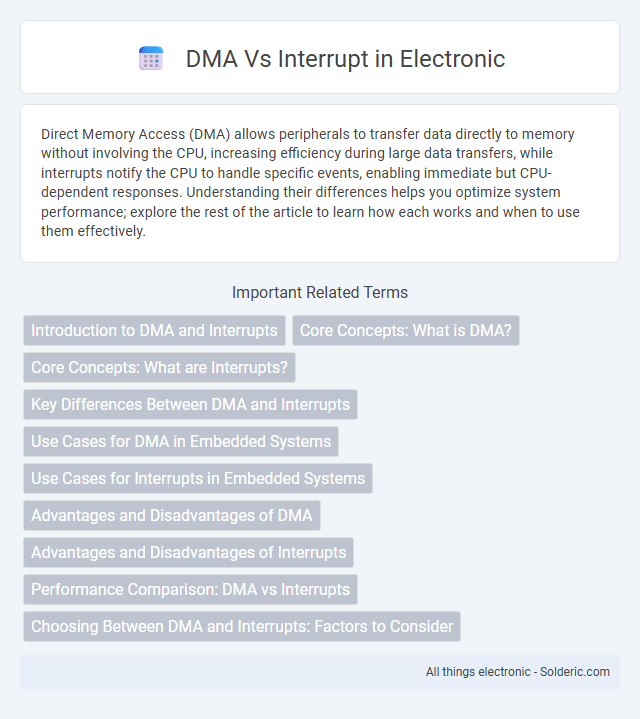Direct Memory Access (DMA) allows peripherals to transfer data directly to memory without involving the CPU, increasing efficiency during large data transfers, while interrupts notify the CPU to handle specific events, enabling immediate but CPU-dependent responses. Understanding their differences helps you optimize system performance; explore the rest of the article to learn how each works and when to use them effectively.
Comparison Table
| Feature | DMA (Direct Memory Access) | Interrupt |
|---|---|---|
| Purpose | Transfers data directly between memory and peripherals without CPU intervention | Notifies CPU to handle specific events or I/O operations |
| CPU Involvement | Minimal, CPU is freed during data transfer | High, CPU pauses current tasks to service interrupt |
| Data Transfer | Efficient bulk data transfer | Usually small data or status signaling |
| Latency | Low, direct access to memory | Variable, dependent on interrupt priority and handling time |
| Use Case | High-speed data transfer (e.g., disk I/O, multimedia) | Event-driven processing (e.g., keypress, timer) |
| Complexity | Requires DMA controller hardware | Requires interrupt controller and service routines |
Introduction to DMA and Interrupts
Direct Memory Access (DMA) allows hardware devices to transfer data directly to or from memory without continuous CPU involvement, improving data throughput and reducing processing overhead. Interrupts are signals sent by hardware or software to the CPU, prompting it to halt current tasks and execute a specific service routine. While interrupts require CPU intervention for each data transaction, DMA enables bulk transfers independently, optimizing system efficiency in data-intensive operations.
Core Concepts: What is DMA?
DMA (Direct Memory Access) is a hardware feature that allows peripherals to transfer data directly to or from memory without involving the CPU, improving system efficiency and speed. Interrupts are signals that alert the CPU to handle specific tasks, temporarily pausing its current processes. Understanding DMA helps optimize your system's data handling by minimizing CPU workload during high-speed data transfers.
Core Concepts: What are Interrupts?
Interrupts are signals sent to the processor to temporarily halt the current execution flow and address urgent tasks, enabling immediate response to hardware or software events. You gain efficient CPU utilization by offloading routine data transfer processes to Interrupt Service Routines (ISRs), which quickly manage event-driven operations. This core concept contrasts with DMA, where data transfers occur independently without CPU intervention, highlighting the responsiveness and control Interrupts provide in real-time processing.
Key Differences Between DMA and Interrupts
DMA transfers data directly between memory and peripherals without CPU intervention, enhancing system efficiency by offloading data movement tasks. Interrupts signal the CPU to pause current processes and execute specific routines in response to events, enabling real-time responsiveness. Your system optimizes performance by balancing DMA for bulk data transfer and interrupts for immediate event handling.
Use Cases for DMA in Embedded Systems
Direct Memory Access (DMA) is ideal for high-speed data transfer tasks in embedded systems, such as audio signal processing, video streaming, and sensor data acquisition, where minimizing CPU intervention is crucial. DMA reduces processor load by autonomously moving data between peripherals and memory, enhancing real-time performance and efficiency. Interrupts are still used for event-driven processes, but DMA excels in continuous, large-block data transfers requiring timely and uninterrupted handling.
Use Cases for Interrupts in Embedded Systems
Interrupts in embedded systems are primarily used for real-time event handling, such as responding to external sensor inputs, timer expirations, or communication module signals. They enable immediate processor attention to critical tasks like emergency shutdowns, user input detection, and peripheral device control, ensuring minimal latency and effective resource management. Interrupt-driven designs optimize system responsiveness, particularly in time-sensitive applications like automotive control units, industrial automation, and consumer electronics.
Advantages and Disadvantages of DMA
Direct Memory Access (DMA) enables peripherals to transfer data directly to memory without CPU intervention, significantly enhancing system efficiency and reducing processor overhead. While DMA offers faster data transfer rates and frees the CPU for higher-priority tasks, it introduces complexity in system design and potential difficulties in synchronizing data access between the CPU and peripherals. Interrupt-driven data transfer provides simpler control and easier debug but can cause higher CPU usage and latency during high-volume data operations compared to DMA.
Advantages and Disadvantages of Interrupts
Interrupts enable efficient CPU utilization by allowing immediate response to high-priority events, reducing processor idle time and improving system responsiveness. However, they can introduce complexity in software design due to the need for interrupt handling routines and potential priority conflicts, which might lead to increased latency or missed events. Interrupt-driven systems may also incur overhead from context switching, impacting overall performance in scenarios with frequent interrupts.
Performance Comparison: DMA vs Interrupts
DMA (Direct Memory Access) significantly improves system performance by offloading data transfer tasks from the CPU, allowing higher throughput and lower latency in memory operations compared to interrupt-driven I/O. Interrupts require the CPU to stop its current tasks to handle I/O requests, causing context switches and increased CPU overhead, which reduces overall efficiency especially in high-speed data transfers. In scenarios requiring large data blocks or continuous transfers, DMA provides superior performance due to minimal CPU intervention, while interrupts are better suited for smaller, less frequent data exchanges.
Choosing Between DMA and Interrupts: Factors to Consider
Choosing between DMA and interrupts depends on factors such as data transfer size, CPU load, and timing requirements. DMA is optimal for large, continuous data transfers because it offloads the CPU, minimizing processing overhead and improving real-time performance. Interrupts are better suited for handling small, sporadic events where immediate CPU attention is required without the complexity of setting up DMA channels.
DMA vs Interrupt Infographic

 solderic.com
solderic.com